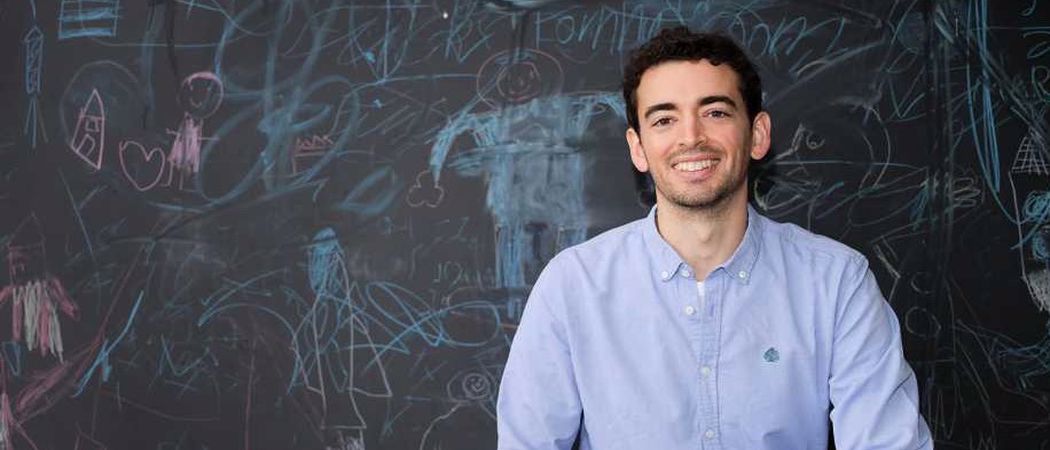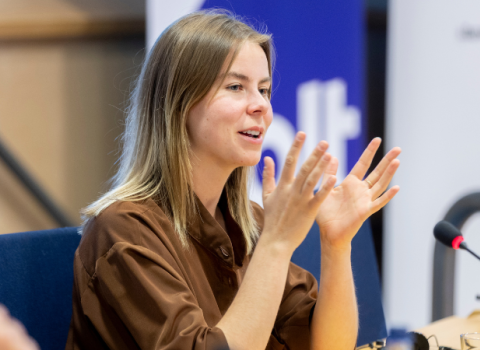
Marc Reig Escalé, ETH Zurich. Photo: ETH Zurich website.
The more connected the world becomes, the greater the demands that data traffic places on communications infrastructure. ETH Pioneer Fellow Marc Reig Escalé and his team develop innovative chips that process information faster than previously possible while requiring even less energy.
It’s not much thicker than a postcard, and a postage stamp looks enormous in comparison. Its surface shimmers blue-black, with gold inlay. Lovingly, its creator holds it up with tweezers as if it were a precious jewel. Marc Reig Escalé has developed a chip that enables high-speed data transmission and could play an essential role in the future of 5G and similar enterprises.
The trend has been clear for years: in an increasingly connected world, in which even fridges automatically reorder supplies when the milk is running low, or office chairs adapt themselves to the backs of their users because they have access to experiential data for millions of other backs, we see huge increases in data traffic. This kind of traffic generally travels along highways of fibre-optic cable. All around the world, whether beneath our streets, strung above ground from mast to mast, or in the depths of the ocean, bundles of these cables carry pulses of light to transmit coded information.
However, just as highways alone aren’t enough to get goods from A to B, because the trucks that drive on them have to be loaded and unloaded, fibre-optic cables are only half the story in the world of data traffic. The information needs to be encoded and decoded. This means it has to be “written” into the light signals and then “read” out again at the end.
Lighting circuits in miniature
With their new chip, Marc Reig Escalé and his colleagues at the Institute for Quantum Electronics at ETH Zurich have found a way to make this “writing” of information much more efficient than was previously possible. The idea was to combine the best materials from the fields of optics and microelectronics in creating the tiny chips. First, there is silicon, the most important material in the computer industry and the element that gave Silicon Valley its name. As a semiconductor, it is exceptionally well suited for building electrical circuits, such as those on the chips in computers and mobile phones. In crystal form, silicon is also used in optical chips to transmit light waves. This has practical advantages, as manufacturing in miniature format is already well established in microelectronics.
For optical purposes, however, silicon is far from the best choice. Lithium niobate offers much more favourable characteristics: for example, it can work with a wider range of light frequencies. An important attribute for data processing is this crystalline material’s ability to alter the intensity of incident light depending on what electrical voltage is applied from the outside. This makes it possible for electrical signals to be transformed into optical signals at high speed – precisely what is needed to “load the trucks” that will be travelling on the data highways.
To date, however, these lithium niobate modulators have been so large that they consume a lot of energy. Happily, Reig Escalé was able to draw on a technology developed at ETH Zurich at the start of the decade to apply extremely thin layers of lithium niobate to the familiar silicon chips. The physicist managed to peel fine structures out of this crystal layer using various etching techniques, into which laser light can be fed. When coupled with delicate gold electrodes, it becomes possible to translate electrical signals very efficiently into optical ones. The emergent laser light contains the information that had previously been sent in an electrical form to the electrodes. “Our chips consume less energy and can process signals at least twice as fast as the commercial alternatives that currently exist,” explains Reig Escalé, who works in the laboratory of ETH Professor Rachel Grange. Metaphorically speaking, this means that an individual chip can load more trucks per unit of time and can therefore serve many more data highways simultaneously as a transshipment terminal.
A rich discovery for the telecommunications sector
This news didn’t take long to attract the interest of industry. With the expansion of the 5G network and plans already being forged for its 6G successor, data rates are soaring to ever more vertiginous heights – and the capabilities of individual components need to rise to the challenge. At the same time, the trend for connecting more and more everyday items, such as fridges and office chairs, to the web – forming what is known as the Internet of Things – means the sheer quantity of data that needs to be processed is skyrocketing.
Reig Escalé still seems nonplussed when he recalls the excitement the new technology generated among the companies with which his group was cooperating during his doctorate. “They were actually interested in the first chip, as primitive as it was!”
And so the physicist is taking the bold leap out of his pure science habitat. “Versics” is the name of the new company he has founded as part of his ETH Pioneer Fellowship. Versics is short for “versatile optics”, since the technology has a wide variety of possible applications – and not even the sky is the limit, as this technology could also be useful for satellite communications.
The first marketable prototype is expected to be ready later this year, and Reig Escalé’s team is working flat out to make it happen. However, manufacturing the chips in the cleanroom and performing quality tests in the optics laboratory, during which each one of these technical jewels is examined with meticulous scrutiny, is by no means the end of the story. The casing had to be designed and connections integrated in accordance with industry standards. Now, it is a matter of putting all the individual parts together while convincing future customers and investors of the plans. As coordinator of the whole project, Reig Escalé is a busy man. “Marketing and research are truly two different worlds!” he admits with a chuckle before going on to praise the energetic and enterprising colleagues and partners he has, both in the lab and out in the business world.
His father was sceptical at first because he ran his own business and knew what awaited his son. However, that has since changed: “My whole family supports me,” he says. And even if Skype contact with friends and family back in Catalonia can’t fully bridge the distance home, Reig Escalé doesn’t seem to feel too out of place in Switzerland. Not only does he like the mix of nationalities and cultures that come together here, but he now speaks almost fluent German and has even subscribed to the Tages-Anzeiger newspaper. After all, there are plenty of other interesting subjects in this world besides fascinating crystals and the connected world of the future.
This article was first published on July 6th by ETH Zurich.




 A unique international forum for public research organisations and companies to connect their external engagement with strategic interests around their R&D system.
A unique international forum for public research organisations and companies to connect their external engagement with strategic interests around their R&D system.